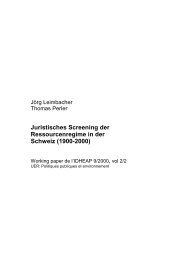Local Government and Metropolitan Regions in Switzerland - IDHEAP
Local Government and Metropolitan Regions in Switzerland - IDHEAP
Local Government and Metropolitan Regions in Switzerland - IDHEAP
You also want an ePaper? Increase the reach of your titles
YUMPU automatically turns print PDFs into web optimized ePapers that Google loves.
is higher <strong>in</strong> left-w<strong>in</strong>g parties, there is also a higher representation of women <strong>in</strong> the biggest cities compared<br />
to smaller towns <strong>and</strong> municipalities. In 2006 the percentage of women <strong>in</strong> the executives of the<br />
eight cities above 50,000 <strong>in</strong>habitants amounted to 34 percent, the one for the parliaments to 37 percent<br />
(Städte 2007). <strong>Local</strong> politics <strong>in</strong> bigger cities not only differ due to higher media coverage <strong>and</strong> different<br />
prerequisites of the citizens to take part (see Ladner/Bühlmann 2007). And f<strong>in</strong>ally, local politicians are <strong>in</strong><br />
general not dependent on their parties at cantonal or national level. The higher party level is not supposed<br />
to <strong>in</strong>terfere <strong>in</strong> the recruitment process.<br />
Section 9: <strong>Local</strong> government role <strong>in</strong> the evolution of the federal system: emerg<strong>in</strong>g issues <strong>and</strong><br />
trends<br />
S<strong>in</strong>ce the 1990s there have been serious attempts to reform local government <strong>in</strong> Switzerl<strong>and</strong>. 27 The<br />
entanglement of tasks <strong>and</strong> the flow of f<strong>in</strong>ancial resources between the two layers have been considered<br />
to be non-transparent, <strong>in</strong>effective <strong>and</strong> <strong>in</strong>efficient, violat<strong>in</strong>g the “pr<strong>in</strong>ciple of fiscal equivalence”. In almost<br />
all cantons there have therefore been more or less serious attempts to review <strong>and</strong> allocate tasks <strong>and</strong><br />
resources to the different layers of the state more adequately (see Ladner/Ste<strong>in</strong>er 1998: 24 ff.). Most of<br />
these reforms also pursued the idea that transfers to the local level should be given on the basis of the<br />
municipalities’ possibilities of rais<strong>in</strong>g their own resources <strong>and</strong> that they should be given <strong>in</strong> the form of<br />
block grants rather than be<strong>in</strong>g tied to the provision of specific tasks.<br />
In some <strong>in</strong>stances (like for example <strong>in</strong> the canton of Berne) the reallocation of tasks led – quite unexpectedly<br />
<strong>and</strong> certa<strong>in</strong>ly not desired by the municipalities – to a shift of tax money to the cantonal level.<br />
However, this shift cannot be seen as a general loss <strong>in</strong> municipal autonomy, s<strong>in</strong>ce the decisional power<br />
of the municipalities <strong>in</strong> the fields which have been transferred to the canton (primary schools, social<br />
security <strong>and</strong> public health) was already very weak. In comparative terms the fiscal autonomy of the<br />
Bernese municipalities still rema<strong>in</strong>s high.<br />
In general, the pr<strong>in</strong>ciples of subsidiarity <strong>and</strong> local autonomy are not questioned <strong>in</strong> the course of these<br />
reforms <strong>and</strong> have been upheld <strong>in</strong> most of the recent revisions of cantonal constitutions. In the future,<br />
however, local autonomy is most likely to be restricted to an “operative autonomy”, whereas strategic<br />
responsibilities will <strong>in</strong>creas<strong>in</strong>gly move to higher state levels. Cantonal authorities will tell the municipalities<br />
what to do, <strong>and</strong> the municipalities will decide how they want to do it.<br />
The cantons have also enforced their legal possibilities to make municipalities co-operate more <strong>in</strong>tensively.<br />
Despite these possibilities such attempts were hardly ever applied before. The idea that municipalities<br />
should work together to provide certa<strong>in</strong> services more efficiently is by no means new. In the<br />
history of Swiss municipalities there have always been some forms of co-operation, which is not astonish<strong>in</strong>g<br />
if we consider the smallness of many municipalities. For <strong>in</strong>ter-municipal co-operation <strong>in</strong> general, it<br />
seems obvious that <strong>in</strong> larger territorial units many services profit from “economies of scales”. But cooperation<br />
also raises questions of democratic decision mak<strong>in</strong>g <strong>and</strong> control. How can decisions be taken<br />
with<strong>in</strong> a union of municipalities of different size if the pr<strong>in</strong>ciple of „one man one vote“ puts smaller municipalities<br />
at a disadvantage? How can delegates on the boards of a union of municipalities be controlled<br />
democratically <strong>and</strong> how, <strong>in</strong> the case of co-operation on the basis of private law, are contracts to<br />
be formulated <strong>and</strong> property rights to be regulated?<br />
Consider<strong>in</strong>g the problems of <strong>in</strong>termunicipal co-operation it is not surpris<strong>in</strong>g that amalgamations of municipalities<br />
have become part of the reform agenda. However, there is hardly any canton which can<br />
27 For a comprehensive coverage of the problems <strong>and</strong> the reform activities of the Swiss municipalities see Geser et al.<br />
(1994), Ladner et al. (2000), Kübler/Ladner (2003) Ladner/Ste<strong>in</strong>er (2005) <strong>and</strong> Ladner (2005b).<br />
19










